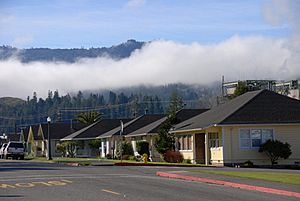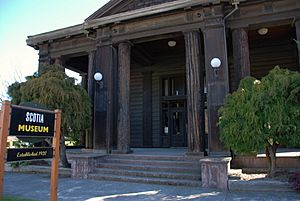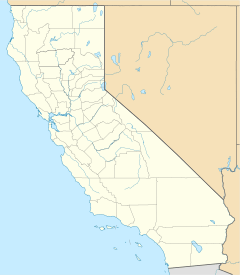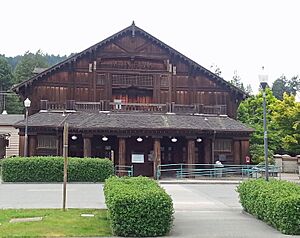Scotia, California facts for kids
Quick facts for kids
Scotia
|
|
|---|---|

Main Street in Scotia
|
|
| Country | |
| State | |
| County | Humboldt |
| Area | |
| • Total | 0.842 sq mi (2.179 km2) |
| • Land | 0.746 sq mi (1.932 km2) |
| • Water | 0.096 sq mi (0.247 km2) 11.3% |
| Elevation | 194 ft (59 m) |
| Population
(2020)
|
|
| • Total | 681 |
| • Density | 808.8/sq mi (312.53/km2) |
| Time zone | UTC-8 (Pacific) |
| • Summer (DST) | UTC-7 (PDT) |
| ZIP code |
95565
|
| Area code | 707 |
| FIPS code | 06-70518 |
| GNIS feature IDs | 232715, 2611446 |
Scotia is a small community in Humboldt County, California. It's located along the Eel River and U.S. Route 101. Scotia is about 8.5 miles (13.7 km) southeast of Fortuna. In 2010, about 850 people lived there.
Scotia was once known as Forestville until 1888. It was a special kind of town called a company town. This means one company, the Pacific Lumber Company (PALCO), owned almost everything in town. They built homes for their workers who worked in the lumber industry. PALCO owned Scotia until 2008. Now, the homes are being sold to individual families.
Contents
History of Scotia
Scotia started in 1863. It was founded by the Pacific Lumber Company to house its workers. The town was built after a big flood in 1861–1862. Another huge flood happened in 1964. During this flood, millions of feet of redwood logs and lumber were washed out of the Scotia sawmill. They were scattered all the way to the Pacific coast.
A railroad line connected Scotia to Humboldt Bay in 1885. This helped transport lumber. Later, in 1914, the town became part of a larger national rail network.
The town's name was changed from Forestville to Scotia in 1888. This was to avoid confusion with another town named Forestville in California. People say the new name, Scotia, was chosen because many residents came from New Brunswick and Nova Scotia in Canada. The name was picked by a coin toss! The first post office in Scotia opened the same year.
Life in Scotia in the early 1900s is shown in the Neill Photo Albums. These albums have 292 pictures of the Neill family and other townspeople. They show daily life, homes, vacations, and the lumber mill operations between 1908 and 1913. You can see these photos at Humboldt State Polytechnic University's library.
Many company towns were built in the Pacific Northwest during the 1800s. Most of them closed during the Great Depression in the 1930s. But Scotia was one of the few that kept going. Most of the houses you see there today were built between the 1920s and 1950s.
Earthquakes and Changes
In 1992, three large earthquakes hit Humboldt County, including Scotia. The first quake caused damage to the lumber mill. The second quake, on April 26, caused the most damage. A fire started in the Hoby's Market shopping center, and the whole center was destroyed. Homes in the North Court area of Scotia were also damaged, and there were gas leaks. For a while, Scotia had no water or electricity. The Pacific Lumber Company later rebuilt the shopping center.
PALCO Company Changes
In 2006, PALCO decided to sell the homes and businesses in Scotia. They thought Scotia might become part of a nearby town called Rio Dell. Also, the lumber mill needed fewer workers because of new machines and less timber.
In 2007, PALCO had financial problems and filed for bankruptcy. In 2008, a new plan was approved. Most of Scotia's properties were transferred to a new company called Town of Scotia Company, LLC. The sawmill and other office buildings went to Humboldt Redwood Company.
Now, the Town of Scotia LLC is working to divide the town into individual lots. This will allow people to buy their own homes and businesses. This process needs approval from local government groups.
What You'll Find in Scotia
Scotia offers several things for its residents and visitors:
- A movie theater
- A museum
- A hotel with the town's only bar and restaurant
- A shopping center
- A school for kids up to eighth grade
- A community recreation center
- A baseball field
- Two churches
The Pacific Lumber Company used to spend about $1 million each year to run the town. There are 274 homes, mostly two to four-bedroom cottages. The town also has a volunteer fire department with 28 members, which PALCO used to fully fund.
PALCO also managed the town's electricity system. As the town is being divided, a new electricity system is being built to modern standards.
Weather in Scotia
Scotia has a warm-summer Mediterranean climate. This means it has warm, dry summers and mild, wet winters. Because it's in a river valley, it can get warmer than coastal areas of Humboldt County. The hottest temperature ever recorded was 104°F (40°C) in September 2017. The coldest was 17°F (-8°C).
Scotia rarely has days where the temperature stays below freezing. The coolest average daily high temperature is around 45°F (7°C). Even in summer, the nights are cool because of the ocean air and fog.
| Climate data for Scotia, California (1991–2020 normals, extremes 1926–present) | |||||||||||||
|---|---|---|---|---|---|---|---|---|---|---|---|---|---|
| Month | Jan | Feb | Mar | Apr | May | Jun | Jul | Aug | Sep | Oct | Nov | Dec | Year |
| Record high °F (°C) | 76 (24) |
82 (28) |
86 (30) |
92 (33) |
97 (36) |
94 (34) |
90 (32) |
93 (34) |
104 (40) |
97 (36) |
81 (27) |
73 (23) |
104 (40) |
| Mean maximum °F (°C) | 66.6 (19.2) |
71.1 (21.7) |
72.3 (22.4) |
76.3 (24.6) |
78.2 (25.7) |
79.2 (26.2) |
80.1 (26.7) |
82.6 (28.1) |
86.3 (30.2) |
85.1 (29.5) |
73.1 (22.8) |
64.8 (18.2) |
90.5 (32.5) |
| Mean daily maximum °F (°C) | 56.6 (13.7) |
57.8 (14.3) |
59.2 (15.1) |
61.6 (16.4) |
64.4 (18.0) |
67.2 (19.6) |
70.0 (21.1) |
71.6 (22.0) |
72.5 (22.5) |
68.6 (20.3) |
60.6 (15.9) |
55.1 (12.8) |
63.8 (17.7) |
| Daily mean °F (°C) | 49.6 (9.8) |
50.3 (10.2) |
51.4 (10.8) |
53.4 (11.9) |
56.5 (13.6) |
59.3 (15.2) |
61.8 (16.6) |
62.9 (17.2) |
62.2 (16.8) |
58.4 (14.7) |
52.7 (11.5) |
48.3 (9.1) |
55.6 (13.1) |
| Mean daily minimum °F (°C) | 42.6 (5.9) |
42.7 (5.9) |
43.5 (6.4) |
45.2 (7.3) |
48.6 (9.2) |
51.4 (10.8) |
53.5 (11.9) |
54.2 (12.3) |
51.9 (11.1) |
48.3 (9.1) |
44.9 (7.2) |
41.6 (5.3) |
47.4 (8.6) |
| Mean minimum °F (°C) | 32.3 (0.2) |
33.3 (0.7) |
35.5 (1.9) |
37.6 (3.1) |
41.9 (5.5) |
45.3 (7.4) |
48.8 (9.3) |
48.8 (9.3) |
44.7 (7.1) |
39.2 (4.0) |
34.8 (1.6) |
32.2 (0.1) |
29.8 (−1.2) |
| Record low °F (°C) | 20 (−7) |
23 (−5) |
29 (−2) |
31 (−1) |
33 (1) |
40 (4) |
40 (4) |
41 (5) |
37 (3) |
28 (−2) |
27 (−3) |
17 (−8) |
17 (−8) |
| Average precipitation inches (mm) | 8.59 (218) |
7.83 (199) |
6.93 (176) |
3.89 (99) |
1.91 (49) |
0.57 (14) |
0.14 (3.6) |
0.05 (1.3) |
0.47 (12) |
2.38 (60) |
5.23 (133) |
9.68 (246) |
47.67 (1,211) |
| Average precipitation days | 17.2 | 15.1 | 16.8 | 14.0 | 9.7 | 5.0 | 1.9 | 1.4 | 2.9 | 7.1 | 13.9 | 17.6 | 122.6 |
| Source: NOAA | |||||||||||||
Visitor Attractions

The Scotia Museum has old items, photos, and displays that tell the town's story. The Fisheries Center lets you see different types of local fish. It's set up to look like their natural home.
The Winema Theater was built in 1919. It was updated in 2002. This building is made of redwood and looks like a Swiss chalet with its exposed wooden beams.
See also
 In Spanish: Scotia (California) para niños
In Spanish: Scotia (California) para niños




